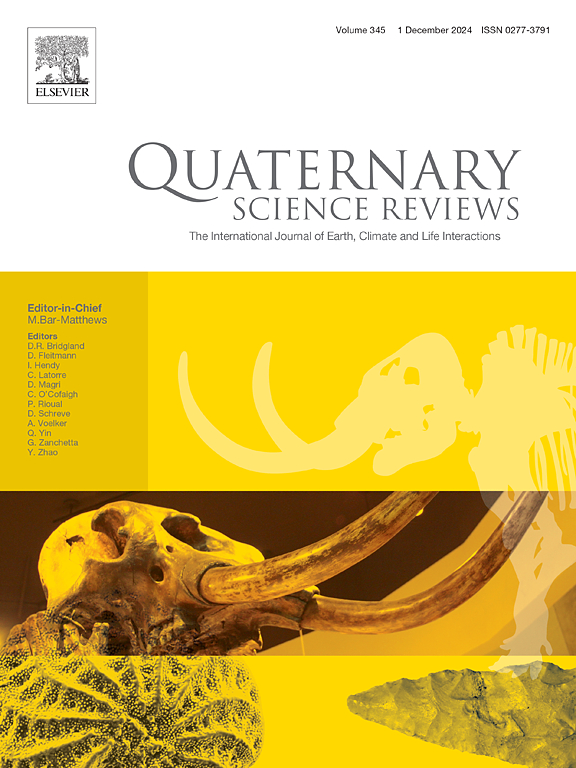植被覆盖在上新世晚期暖期东亚夏季风偶极子格局变化中的关键作用
IF 3.3
1区 地球科学
Q1 GEOGRAPHY, PHYSICAL
引用次数: 0
摘要
上新世晚期暖期是最近的地质暖期,大气CO2浓度与今天相似(~ 405 ppm),但高于现代参考工业化前时期(280 ppm),具有明显的植被覆盖。CO2浓度和植被覆盖都影响全球和区域气候,但它们在东亚夏季风(EASM)中的相对作用尚不清楚。本研究通过敏感性实验评估了上新世晚期植被变化和CO2增强对东亚热通量的影响。与工业化前相比,晚上新世东亚季风在中国东部夏季降水变化中以经向偶极子模式增强。植被覆盖度的变化对东亚热偶极子格局的形成起主要作用,CO2浓度的升高对东亚热偶极子格局的形成起次要作用。上新世晚期植被引起了地表反照率的偶极子变化,在50-65°N处增加,在30-50°N处减少,从而改变了整个亚洲大陆的区域热结构。结果,对流层变暖在中纬度地区更为明显,主要是由反照率反馈驱动的。植被引起的东亚热结构调整增强了夏季风,并通过非绝热加热改变增加了向北的水汽输送。这一过程可能导致了东亚夏季降水的偶极子型,受西风带向极移引起的二次环流的影响。我们的实验强调了植被在上新世晚期东亚寒流变化格局中的关键作用,并强调了植被反馈在未来变暖世界中的重要性。本文章由计算机程序翻译,如有差异,请以英文原文为准。
The crucial role of vegetation cover in shaping the dipole pattern of East Asian summer monsoon changes during the late Pliocene warm period
The late Pliocene warm period is the most recent geological warm period with atmospheric CO2 concentrations similar to today's (∼405 ppm) but higher than the modern reference pre-industrial period (280 ppm), featured distinct vegetation cover. Both CO2 concentrations and vegetation cover influence global and regional climate, but their relative roles in the East Asian summer monsoon (EASM) are not well understood. In this study, we assess the impacts of vegetation change and CO2 enhancement on the EASM during the late Pliocene through sensitivity experiments. Compared to the pre-industrial period, the EASM intensified with a meridional dipole pattern in summer precipitation change over East China during the late Pliocene. Changes in vegetation cover played a major role in shaping the dipole pattern of EASM variation, while elevated CO2 alone played a minor role. The late Pliocene vegetation caused a dipole pattern in surface albedo changes, increasing at 50–65°N and decreasing at 30–50°N, thereby altering the regional thermal structure across the Asian continent. As a result, tropospheric warming was more pronounced at mid-latitudes, primarily driven by albedo feedback. The vegetation-induced adjustment of thermal structure over East Asia enhanced the summer monsoon and increased northward water vapor transport through diabatic heating modification. This process likely contributed to the dipole pattern of summer precipitation over East Asia, influenced by the secondary circulation due to the poleward shift of the westerlies. Our experiments highlight the crucial role of vegetation in EASM variation pattern during the late Pliocene and underscore the importance of the vegetation feedback in a future warming world.
求助全文
通过发布文献求助,成功后即可免费获取论文全文。
去求助
来源期刊

Quaternary Science Reviews
地学-地球科学综合
CiteScore
7.50
自引率
15.00%
发文量
388
审稿时长
3 months
期刊介绍:
Quaternary Science Reviews caters for all aspects of Quaternary science, and includes, for example, geology, geomorphology, geography, archaeology, soil science, palaeobotany, palaeontology, palaeoclimatology and the full range of applicable dating methods. The dividing line between what constitutes the review paper and one which contains new original data is not easy to establish, so QSR also publishes papers with new data especially if these perform a review function. All the Quaternary sciences are changing rapidly and subject to re-evaluation as the pace of discovery quickens; thus the diverse but comprehensive role of Quaternary Science Reviews keeps readers abreast of the wider issues relating to new developments in the field.
 求助内容:
求助内容: 应助结果提醒方式:
应助结果提醒方式:


